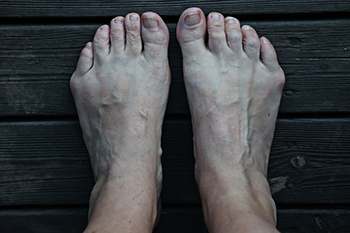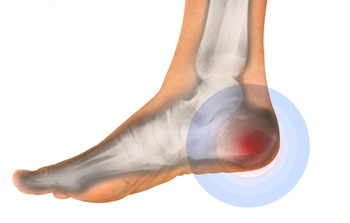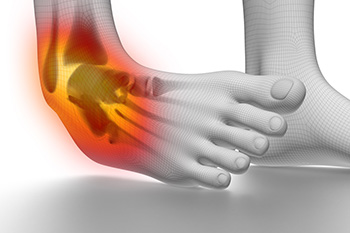June 2022
What is a Bunionette?

A bunionette is a prominent deformity at the base of the fifth (or little) toe. It can be painful, particularly if it rubs against a tight-fitting shoe. This mini bunion occurs if the bone of the midfoot angles out and the little toe angles in, leading to a bony prominence. The toe might hurt on the outside or inside if that toe rubs against the fourth toe. Wearing wider shoes with space to accommodate the bump, wearing a toe spacer, or padding the bump will help prevent further irritation. Depending on the severity of the bump, it may be necessary to limit walking or standing. Surgery to remove the bunionette or reposition the baby toe are options when these do not work. If you have a bunionette, consult with a podiatrist who can take an X-ray to confirm the problem and provide treatment that is right for you.
If you are suffering from bunion pain, contact one of our podiatrists of Bazzi Podiatry. Our doctors can provide the care you need to keep you pain-free and on your feet.
What Is a Bunion?
Bunions are painful bony bumps that usually develop on the inside of the foot at the joint of the big toe. As the deformity increases over time, it may become painful to walk and wear shoes. Women are more likely to exacerbate existing bunions since they often wear tight, narrow shoes that shift their toes together. Bunion pain can be relieved by wearing wider shoes with enough room for the toes.
Causes
- Genetics – some people inherit feet that are more prone to bunion development
- Inflammatory Conditions - rheumatoid arthritis and polio may cause bunion development
Symptoms
- Redness and inflammation
- Pain and tenderness
- Callus or corns on the bump
- Restricted motion in the big toe
In order to diagnose your bunion, your podiatrist may ask about your medical history, symptoms, and general health. Your doctor might also order an x-ray to take a closer look at your feet. Nonsurgical treatment options include orthotics, padding, icing, changes in footwear, and medication. If nonsurgical treatments don’t alleviate your bunion pain, surgery may be necessary.
If you have any questions, please feel free to contact one of our offices located in Detroit, West Detroit, Northwest Detroit, Sterling Heights, Hamtramck, Dearborn Heights, Madison Heights, Redford, and Livonia, MI . We offer the newest diagnostic and treatment technologies for all your foot care needs.
What Causes Heel Bursitis?

In addition to the many bones, tendons, ligaments, and muscles found in the foot, it also contains bursa. These sacs of fluid act as cushions between tendons, muscles, and bones, and can be found in the heel. When a bursa becomes inflamed, it is called bursitis. There are two types of heel bursitis, retrocalcaneal and subcutaneous calcaneal. Retrocalcaneal bursa are found in the back of the ankle near the heel. When it becomes inflamed, it can be mistaken for Achilles tendonitis because it develops behind the heel. It is caused by overuse or repetitive activity – too much walking, running, or jumping. It can be set off by changes in the level of activity, improper training, or a history of arthritis. Subcutaneous calcaneal bursitis is the result of a thinning of the heel pad, and the pain seems to radiate from inside the heel. Ill-fitting footwear, being overweight, stress fractures, and tumors on the foot all can contribute to heel bursitis. If you are experiencing heel pain, it is suggested you consult a podiatrist for a complete examination to determine the cause and find the appropriate treatment options.
Many people suffer from bouts of heel pain. For more information, contact one of our podiatrists of Bazzi Podiatry. Our doctors can provide the care you need to keep you pain-free and on your feet.
Causes of Heel Pain
Heel pain is often associated with plantar fasciitis. The plantar fascia is a band of tissues that extends along the bottom of the foot. A rip or tear in this ligament can cause inflammation of the tissue.
Achilles tendonitis is another cause of heel pain. Inflammation of the Achilles tendon will cause pain from fractures and muscle tearing. Lack of flexibility is also another symptom.
Heel spurs are another cause of pain. When the tissues of the plantar fascia undergo a great deal of stress, it can lead to ligament separation from the heel bone, causing heel spurs.
Why Might Heel Pain Occur?
- Wearing ill-fitting shoes
- Wearing non-supportive shoes
- Weight change
- Excessive running
Treatments
Heel pain should be treated as soon as possible for immediate results. Keeping your feet in a stress-free environment will help. If you suffer from Achilles tendonitis or plantar fasciitis, applying ice will reduce the swelling. Stretching before an exercise like running will help the muscles. Using all these tips will help make heel pain a condition of the past.
If you have any questions please contact one of our offices located in Detroit, West Detroit, Northwest Detroit, Sterling Heights, Hamtramck, Dearborn Heights, Madison Heights, Redford, and Livonia, MI . We offer the newest diagnostic and treatment technologies for all your foot and ankle needs.
How Long Do I Wear a Boot or Cast for My Broken Foot?

A broken foot can happen for a variety of reasons. These can include falling, dropping a heavy object on it, or possibly from twisting it. An X-ray is typically taken which can determine the severity of the break. This is followed by wearing a cast or boot for approximately six weeks. This is a successful method in stabilizing the foot as the healing process occurs. A broken foot is often accompanied by pain and swelling, and it can help to frequently elevate the foot. After the foot has healed, some patients can benefit from performing specific stretches that may help to improve range of motion. These can consist of pointing and flexing the affected foot, followed by turning the feet in and out. If you have broken your foot, it is strongly suggested that you consult with a podiatrist as quickly as possible who can diagnose and treat it.
A broken foot requires immediate medical attention and treatment. If you need your feet checked, contact one of our podiatrists from Bazzi Podiatry. Our doctors can provide the care you need to keep you pain-free and on your feet.
Broken Foot Causes, Symptoms, and Treatment
A broken foot is caused by one of the bones in the foot typically breaking when bended, crushed, or stretched beyond its natural capabilities. Usually the location of the fracture indicates how the break occurred, whether it was through an object, fall, or any other type of injury.
Common Symptoms of Broken Feet:
- Bruising
- Pain
- Redness
- Swelling
- Blue in color
- Numbness
- Cold
- Misshapen
- Cuts
- Deformities
Those that suspect they have a broken foot shoot seek urgent medical attention where a medical professional could diagnose the severity.
Treatment for broken bones varies depending on the cause, severity and location. Some will require the use of splints, casts or crutches while others could even involve surgery to repair the broken bones. Personal care includes the use of ice and keeping the foot stabilized and elevated.
If you have any questions please feel free to contact one of our offices located in Detroit, West Detroit, Northwest Detroit, Sterling Heights, Hamtramck, Dearborn Heights, Madison Heights, Redford, and Livonia, MI . We offer the newest diagnostic and treatment technologies for all your foot and ankle needs.
Gout Pain Can Be Managed
Ankle Sprains Are a Common Ankle Injury
 The ankle is a complex joint composed of several bones, ligaments, tendons, nerves, and muscles. Because it is critical in moving the foot in a variety of ways, the ankle is prone to becoming injured. One of the most common types of ankle injuries is an ankle sprain. This occurs when one or more ligaments that support and bind the ankle are stretched beyond their normal bounds and become injured or torn (either partially or fully). The pain and complexities of an ankle sprain can vary, depending upon how severe it has become injured and whether the ligament has torn. It is important to seek treatment from a podiatrist for any type of ankle sprain, as an improperly healed ankle sprain is likely to lead to additional sprains and possibly even chronic ankle instability.
The ankle is a complex joint composed of several bones, ligaments, tendons, nerves, and muscles. Because it is critical in moving the foot in a variety of ways, the ankle is prone to becoming injured. One of the most common types of ankle injuries is an ankle sprain. This occurs when one or more ligaments that support and bind the ankle are stretched beyond their normal bounds and become injured or torn (either partially or fully). The pain and complexities of an ankle sprain can vary, depending upon how severe it has become injured and whether the ligament has torn. It is important to seek treatment from a podiatrist for any type of ankle sprain, as an improperly healed ankle sprain is likely to lead to additional sprains and possibly even chronic ankle instability.
Although ankle sprains are common, they aren’t always minor injuries. If you need your ankle injury looked at, contact one of our podiatrists from Bazzi Podiatry. Our doctors can provide the care you need to keep you pain-free and on your feet.
How Does an Ankle Sprain Occur?
Ankle sprains are the result of a tear in the ligaments within the ankle. These injuries may happen when you make a rapid shifting movement while your foot is planted. A less common way to sprain your ankle is when your ankle rolls inward while your foot turns outward.
What Are the Symptoms?
- Pain at the sight of the tear
- Bruising/Swelling
- Ankle area is tender to touch
- In severe cases, may hear/feel something tear
- Skin discoloration
Preventing a Sprain
- Wearing appropriate shoes for the occasion
- Stretching before exercises and sports
- Knowing your limits
Treatment of a Sprain
In many cases, the RICE method (Rest, Ice, Compression, and Elevate) is used to treat ankle sprains. However, you should see a podiatrist to see which treatment option would work best with your injury. In severe cases, surgery may be required.
It is important to ask your doctor about rehab options after you receive treatment for your injury. Stretching, strength training, and balance exercises may help the ankle heal while also preventing further injury.
If you have any questions, please feel free to contact one of our offices located in Detroit, West Detroit, Northwest Detroit, Sterling Heights, Hamtramck, Dearborn Heights, Madison Heights, Redford, and Livonia, MI . We offer the newest diagnostic and treatment technologies for all your foot care needs.





